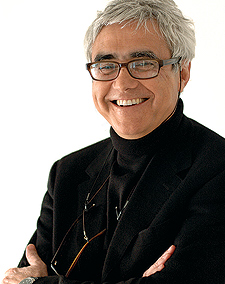Asking a Lot
|
Rafael Viñoly, one of architecture’s biggest names, indulged his love of music by designing a set for Chicago Opera Theater’s The Return of Ulysses by Claudio Monteverdi. So when the curtain goes up this month, the faithful Penelope will be awaiting her long-lost husband on Viñoly’s multitiered island of Ithaca afloat on an endless expanse of sea that surrounds the orchestra and reaches to the audience. No stranger to music, Viñoly keeps a grand piano in his New York office, a reminder that he studied to be a concert pianist before turning to architecture. In fact, some of his most famous designs are for concert halls-Philadelphia’s Kimmel Center and the Tokyo International Forum. While some of his buildings house theatres, Ulysses is only his third stage set. “Opera requires thinking in a different key than architecture, though both deal with the nature of space,” he says. “You have to make the connection between the musical and visual environments.” He adds, referring to director Diane Paulus, “I took my cue from Diane’s focus on Penelope’s loneliness and sense of expectation.” Coincidentally, his father was a stage and screen director, so in roundabout fashion, Ulysses offered Viñoly a way to reconnect with his childhood.
-Anne Spiselman
The Return of Ulysses, March 28, 30; April 1, 5, and 7. Harris Theater, 205 E. Randolph. Tickets: 312-704-8414.
Flyin’ Again
Eleven years ago, Ron OJ Parson directed the Chicago première of Pearl Cleage’s Flyin’ West. Back then, in a tiny, tiny space on Bryn Mawr Ave-nue, a spellbound audience surrounded a compact set while the cast told the story of four African American women pioneers living in Nicodemus, a small town settled by blacks on the inhospitable Kansas plains in the late-800s. This month, Parson is set to direct the play again, this time in a production at Court Theatre (see Theatre).
The History >> To populate the thinly settled Western states, the Homestead Act of 1860 offered 320 acres to any U.S. citizen willing to work the land. Facing oppression in the South and the chaos of Reconstruction, many African Americans took the offer and headed West, establishing all-black towns like Nicodemus.
The Director >> Parson, who began directing in the early 1970s at the University of Michigan, started the Onyx Theatre Ensemble here in Chicago. He staged Cleage’s play “because it covered so many issues-the migration of blacks to the West, domestic violence. Plus, it dealt with very strong female characters, which you don’t find a lot.”
The Women >> The four are Sophie Washington, the bulwark of the family; her sister Fannie Dove, who tries to civilize the prairie with flowers and fine china; Miss Leah, an elderly woman who lives with them; and the youngest sister, Minnie, who arrives with her husband.
The Men >> Dependable, steadfast Wil Parrish, who is courting Fannie; and Minnie’s abusive husband, light-skinned Frank Charles, who derides his wife for her three-shades-darker skin color.
Eleven Years Later >> “I’m ten years older and I hope wiser,”Parson says. “This time around with the play, there will be more subtext that I didn’t deal with before-the reason these people moved west, domestic violence, stifled ambition, the issue of color-light-skin versus dark skin-and Frank’s pain, which comes across as evil. Some of the actors are the same and they’re older and wiser, too. I think we can say the same things we did back then-just deeper.”
–Gale Kappe



